Music Reviews
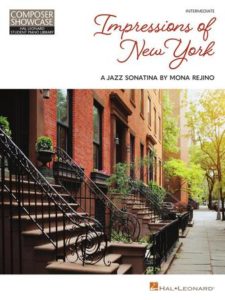
Impressions of New York by Mona Rejino
Review by Andrew Eales for Pianodao – The Way of the Piano, July 26, 2023
In my recent review of Texan composer Mona Rejino’s excellent Reflections and Relaxations (which you can read here), I both mentioned and praised her Impressions of New York, another fairly recent publication in Hal Leonard’s ‘Composer Showcase’ series.
In this review I am returning to that 2021 title to tell you more about it, having intended on reviewing it here and introducing it to the Pianodao Music Library for some time.
Subtitled A Jazz Sonatina, the three moment work was originally commissioned as a trio for viola, cello and piano, and by the Music Teachers National Association in the US for their 2019 National Conference.
Encouraged by its reception, her editor and husband, Rejino subsequently arranged the three movements as the solo piano Jazz Sonatina reviewed here…
Click here to continue reading.
 Reflections & Relaxations by Mona Rejino
Reflections & Relaxations by Mona Rejino
Review by Andrew Eales for Pianodao – The Way of the Piano, July 22, 2023
Mona Rejino’s name will be familiar to all who use the Hal Leonard Student Piano Library or the Hal Leonard Adult Piano Method books, as she not only co-authored those series but contributed many of the included pieces and arrangements.
Rejino has also composed a number of her own piano collections in the Composer Showcase series, an imprint through which Hal Leonard provides a platform for their best pedagogic composers to take the spotlight and present their latest repertoire.
Rejino’s collections in this series have proven stimulating and musically diverse. Like those collections, Reflections & Relaxations is suitable for late intermediate players, and I would say that a player around UK Grade 5 would find enjoyment and sufficient challenge in these eight “peaceful piano solos”.
Introducing the collection, Rejino tells us,
“In today’s fast-paced environment, we often forget to take time to simply breathe, reflect and relax. This collection of pieces is designed to give you the opportunity to reflect on various elements of life, past and present. It provides a musical avenue for you to relax, to stop and smell the roses, even on a busy day. It includes six original compositions, an Irish folksong, and a traditional spiritual. Wishing you peace and joy as you contemplate life through this music.”
The last point is a telling one. Rather than contemplative mediations which nod towards eastern spiritual traditions, these prove to be easy-going pieces in a popular western style that isn’t too far removed from the music of Disney cartoons, so beloved by younger players.
These are happy pieces which stir warm emotions and reflect nostalgically on life’s better moments, encouraging relaxation and emotional connection through accessible tunes with evocatively suggestive titles…
Click here to continue reading.
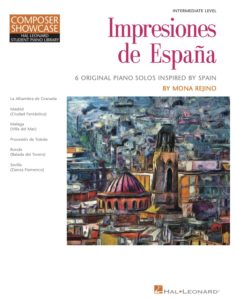 Impresiones de Espana, by Mona Rejino, published by Hal Leonard; Intermediate
Impresiones de Espana, by Mona Rejino, published by Hal Leonard; Intermediate
Winter 2020-2021, Vol. 12, No. 5 – Piano Magazine
After a trip to central and southern Spain, while the sights and sounds were still fresh in her memory, Rejino thoughtfully put pencil to manuscript paper and composed Impresiones de Espana, a collection of six intermediate-level piano solos. In her introductory notes, she writes: “The many musicians performing on the streets and sharing their love of music with others moved me to do the same.” This collection is guaranteed to take you and your students on an exciting trip to Spain without ever leaving the piano bench.
To heighten the performer’s experience, Rejino writes a paragraph about the cities, architecture, artists, and dances that inspired each composition. Castanets, tambourines, the click of a boot heel, and the distinctive rhythmic hand clapping are all here. Imagine the brilliant sounds of trumpets in the pasodoble, the guitar improvisations of the passionate flamenco, the tranquil serenades of the tuna singers, or the lyric melodies of the zarzuela. Rejino’s knowledge of Spanish scales and harmonic progressions is evident; each piece is unique, but the essence is unmistakably Spanish.
Rejino incorporates plenty of technical variety. The graceful “La Alhambra de Granada,” in 6/8 meter, features a left-hand sixteenth-note triplet within a repetitive rhythmic pattern. “Malaga” employs a two-against-three pattern. Energetic “Madrid” has a series of parallel second-inversion chords and winding scale passages. “Procesion de Toledo” opens with a dramatic maestoso section, followed by a lively dance. A page of fast and fiery triplets at the beginning of “Ronda” leads to a cantabile section with lush right-hand arpeggiated chords suggesting guitar strums; the left hand carries the gentle melody. In “Sevilla,” a steady off-beat rhythmic pattern requires careful control of the left-hand thumb for proper balance.
To enhance the musical experience, students could research the scales and harmonies prevalent in Spanish music, the centuries of cultural influences, and/or the traditional dances associated with the music. -Reviewed by Carmen Doubrava
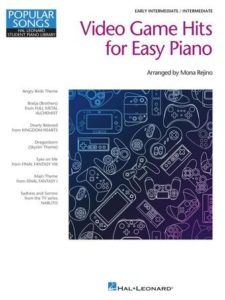 Video Game Hits for Easy Piano, arranged by Mona Rejino, published by Hal Leonard; Early Intermediate/Intermediate
Video Game Hits for Easy Piano, arranged by Mona Rejino, published by Hal Leonard; Early Intermediate/Intermediate
Winter 2021, Vol. 70, No. 3 – Piano Guild Notes
Students enjoy playing things they know and they spend a lot of time playing video games. This collection will entice them to go to the piano and play the music they have heard before! This collection of pieces is all intermediate level and very idiomatic to the piano. There is enough fingering to help the hand feel comfortable and suggested dynamics and pedal markings. The first piece is “Angry Birds Theme” in e minor which students will enjoy playing. The fingering is excellent which will help students develop a good solid hand position with the emphasis on 5ths and 5-finger patterns. “Bratja” is written in d minor and is very lyrical with a broken interval accompaniment in the left hand and a comfortable right-hand singing melody. “Dearly Beloved” is quite slow with right hand figures that are dotted with repeated notes, but the fingering helps the student develop good habits from the beginning. Two pieces by Nobuo Uematsu are included: “Eyes on Me” and “Main Theme from Final Fantasy I.” These are both rather lengthy, but are so lovely students will want to put in the time to learn them. -Reviewed by Dr. Vicki King
June/July 2020 – American Music Teacher
This collection of pieces for solo piano is another addition to Hal Leonard Student Piano Library’s large collection of supplementary intermediate repertoire. Published as a part of the Popular Songs series, this volume contains seven early- to mid-intermediate arrangements of themes from popular video games ranging in time from Final Fantasy I from 1987 to Skyrim from 2011.
The pieces are organized alphabetically by title starting with the Angry Birds Theme. With short bursts of right-hand sixteenth-note figures and sharp rhythms, the theme from the popular mobile device game is reminiscent of the quirky folk character often found in the pedagogical works of Dmitri Kabalevsky. The following piece in the collection, “Bratja” from anime-adapted video game Full Metal Alchemist has the characteristics of a contemporary song without words. Expressive and effectively arranged, it requires a right-hand cantabile melody throughout with a simple accompaniment that transforms through slight variations in texture. The arrangements with the most musical and technical demands are from the Final Fantasy and Skyrim series. “Eyes on Me” from Final Fantasy VIII and “Main Theme” from Final Fantasy I explore more of the keyboard through frequent register and textural shifts. “Dragonborn” from the open world video game Skyrim is the longest work of the collection. This dramatic pre-battle anthem is similar in affect to “O Fortuna” from Carmina Burana and would be a challenging and engaging recital piece.
The variety of character and technical demands in this collection make it a great option not only for students familiar with video game music, but also those that enjoy movie soundtracks and descriptive or programmatic character pieces. As an experienced pedagogical arranger and composer, Mona Rejino has kept the sophistication of the original music while providing a technically unified accessibility for intermediate students. -Reviewed by Andy Villemez, Cincinnati, Ohio
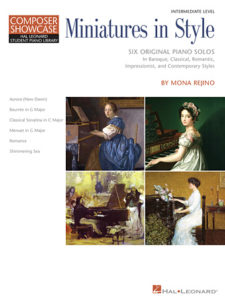 Miniatures in Style: Six Original Piano Solos in Baroque, Classical, Romantic, Impressionist, and Contemporary Styles, by Mona Rejino, published by Hal Leonard; Intermediate
Miniatures in Style: Six Original Piano Solos in Baroque, Classical, Romantic, Impressionist, and Contemporary Styles, by Mona Rejino, published by Hal Leonard; Intermediate
March/April 2016 – Clavier Companion
Celebrated pedagogical composer Mona Rejino provides pleasing new repertoire options for students in this collection, stating that the pieces are “in the style of the keyboard works of the masters…designed to provide a link between early-level method books and intermediate masterwork repertoire.” The inside cover provides short descriptions of the five styles represented.
The two Baroque-style pieces, Bouree in G Major and Menuet in G Major, are charming works that feature typical Baroque devices such as imitation and sequence. Ornaments are notated: for example, a trill beginning on the upper note appears as four sixteenth notes, tied to the following principal note. Slurs and staccato marks are abundant, and they help the student get a feel for the conventions of Baroque articulation. The pieces are similar in character and writing to some of the works in the Notebook for Anna Magdalena Bach, but are just slightly easier to play.
The first movement of Classical Sonatina in C Major, with its simple melodies, primary chord harmonies, and Alberti bass accompaniment, sounds like it could be found among the compositions of Attwood or Latour. The slow second movement and quick finale, however, include some adventurous harmonies that give them away as modern works.
The order of the next two pieces is somewhat confusing. Although the table of contents lists the Romantic-style Romance before the Impressionistic Shimmering Sea (as one would expect in a chronological listing), the order of the two pieces is reversed in the score. Perhaps this publishing change was for layout reasons, but adding a blank page would have maintained the logic.
Fluttering sixteenth notes in Shimmering Sea are reminiscent of Debussy, but harmonies rooted in C minor and touched with chromaticism (along with the dramatic melody of the middle section) are more German Romanticism than Impressionism, Nonetheless, the piece is engaging and enjoyable.
The lyrical and lovely Romance which is filled with colorful modulations, might pass for a Disney tune. To me, it sounds more popular than nineteenth-century Romantic, but many students are sure to enjoy it.
The piece in Contemporary style, “Aurora: New Dawn,” is a contemplative work containing numerous parallel fifths and constant pedaling. It is tonally, rhythmically, and metrically simple, and very accessible to students.
An enjoyable new collection. -Reviewed by Suzanne Schons
December/January 2015/2016—American Music Teacher
Hal Leonard has released a new volume of works in its Composer Showcase series, which features collections of works by well-known composer/pedagogues such as Phillip Keveren, Tony Caramia, Eugenie Rocherolle and Jennifer Linn to name just a few! The latest volume by pianist and teacher, Mona Rejino contains six works (really eight if you count all the movements of the sonatina) that are early-intermediate to intermediate in level and cover a wide range of styles and genres.
The collection begins with a “Bouree” and “Menuet,” written in the baroque style. These works are of similar difficulty both musically and technically when compared to the easiest works in Bach’s Anna Magdalena Notebook. It begs the question: “Why do we need to play these pieces when students could play the actual works by Bach?” That being said, the “Menuet” and other works in the collection regularly feature melodic material for the left hand, which will help students develop independence of the hands. The sonatina is written very much in the style of a classical-era sonatina, with no surprises.
The most successful pieces are the two works written in the romantic style. “Shimmering Sea” features broken chords split between the hands, a contrasting middle section, and well-written figuration in the coda that will fit nicely in the hand of younger students. “Romance” is a beautifully lyric work and in it we hear more of the composer’s own voice, and in this writer’s opinion, that is what makes these two works successful. One can imagine these compositions being popular recital options for students at the intermediate level, as they sound a bit more difficult than the pattern-oriented writing would indicate.
As always, Hal Leonard’s editions are clearly laid out, with thoughtfully placed page turns. The fingering is excellent, with appropriate pedal indications where needed. The background material in the front is adequate, although a little more information about the dances and character pieces (country of origin, typical form and the like), would be helpful. Because of the excellent idiomatic keyboard patterns they contain, these works would make excellent sight-reading material for more advanced students, as well as recital selections for students seeking out more unique repertoire choices. -Reviewed by Scott Beard, NCTM, Shepherd University
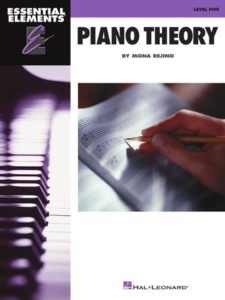
Piano Theory, Level Five, by Mona Rejino, published by Hal Leonard
Summer 2015, Vol. 65, No. 1 – Piano Guild Notes
Piano Theory is part of the Essential Elements course for students from Level One to Level Five. New concepts are introduced at each level. In Level Five, there are eleven units focusing on time signatures, primary triads and inversions, relative minor keys and scales, and musical signs and terms. Each unit has a review page as well as “Musical Mastery,” where students are asked to apply their knowledge to a piece of music. Ear training is included within the review test. A practical and valuable addition to the student’s learning. -Reviewed by Dr. Sandra Stewart
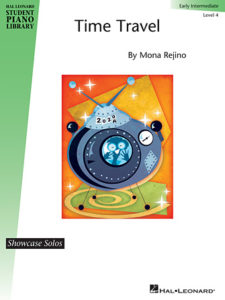 Time Travel, by Mona Rejino, published by Hal Leonard; Early Intermediate
Time Travel, by Mona Rejino, published by Hal Leonard; Early Intermediate
Summer 2014, Vol. 64, No. 1 – Piano Guild Notes
This piece is from Level 4 of the Showcase Solos. It is written in the unusual meter of 3 plus 3 plus 2 eighth notes per bar. Once the student is able to clap this rhythm successfully, they will have fun with it. There are many open 5ths to reinforce a good strong hand position. Ms. Rejino uses an economy of melodic material to make the piece an easy one to memorize. -Reviewed by Dr. Vicki King
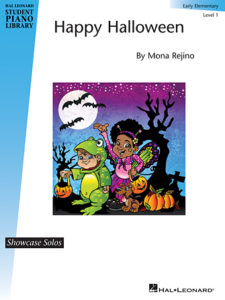 Happy Halloween, by Mona Rejino, published by Hal Leonard; Early Elementary
Happy Halloween, by Mona Rejino, published by Hal Leonard; Early Elementary
Spring 2014, Vol. 63, No. 4 – Piano Guild Notes
This very easy piece with left thumb on C, right thumb on D, is an excellent first recital piece for a beginner. Ms. Rejino writes a cute piano teacher’s part to make the student feel comfortable by having the teacher sit with him at the bench. The student gets to play high “A” to end the piece with a good “boo.” -Reviewed by Dr. Vicki King
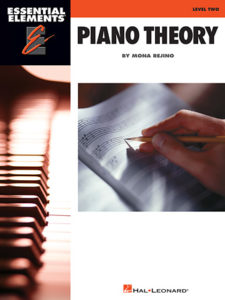
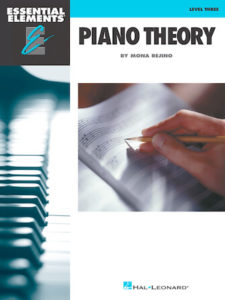
Essential Elements Piano Theory, Levels 2 and 3, by Mona Rejino, published by Hal Leonard
October/November 2013 – American Music Teacher
These theory books are comprehensive and can be used as companion books to standard piano literature or lesson books. While providing comprehensive musicianship focus on reading, writing, listening, transposing and improvising, these skills are covered in the “Musical Mastery” sections. Each book is organized into units and includes three “Musical Mastery” units and one “Theory Mastery” unit.
Unit 1 is a review of the previous level book. Books 2 and 3 present three pages each of ample written review activities.
Units 2-7 introduce written work for six musical concepts. Book 2 covers note naming, musical signs and terms, rhythm and time signatures, recognizing and writing intervals, sharps, flats and naturals. Book 3 covers rhythm and time signatures, accidentals and enharmonic notes, half and whole steps, major five-finger patterns and triads, minor five-finger patterns and triads, and musical signs and terms.
Unit 8 is a review of each book’s six musical concepts. Books 2 and 3 present three pages each of ample written review activities.
The books contain three interspersed “Musical Mastery” sections. Book 2 covers ear training, Italian words and symbols, improvisation, reading, analysis, a riddle and crossword puzzle. Book 3 covers ear training, rhythms, reading, transposing, and identifying major and minor patterns.
Also included is one final “Theory Mastery” section. Book 2 reinforces its concepts and musicianship skills in four pages. Book 3 reinforces its concepts and musicianship skills in three pages.
One suggestion is to work the music mastery skills into the concept units. Another is to clearly state directions so there is little room for confusion or speculation. Teachers will still need to make sure students read and carefully follow instructions. -Reviewed by Barbara A. Brown, Charlotte, North Carolina
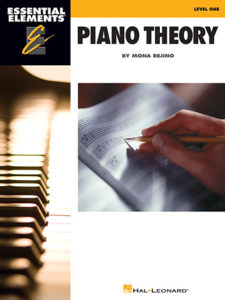 Piano Theory, Levels One, Two and Three, by Mona Rejino, published by Hal Leonard
Piano Theory, Levels One, Two and Three, by Mona Rejino, published by Hal Leonard
Fall 2013, Vol. 63, No. 2 – Piano Guild Notes
This new publication is designed especially for the pianist and makes the connection of theory concepts to basic keyboard theory. Each unit has creative exercises that apply to piano music. Level One covers the introductory lessons of naming keys, basic rhythms, understanding of finger numbers, and note reading on the staff. It works through the five-finger patterns of C and G. Ear training exercises are given for recognition of high and low sounds, rhythm patterns, same or different pitches, and up and down groups of notes.
In Level Two, the author continues the same structure and introduces five-finger improvisation. Intervals up to a fifth are explored with writing exercises and games. Other concepts include sharps, flats and naturals, the grand staff, and dynamics. Rejino also uses sight-reading and transposing as part of the learning process. Note naming expands to the full grand staff in Level Three. Rhythmic concepts expand to eighth note reading. Major five-finger patterns of C, F, G, D, A, and E are explained after drills on half and whole steps. The book immediately follows with minor patterns. Ear training drills test the student’s ability to hear the difference. This level ends with musical signs and terms, music math, and review pages.
A particularly interesting concept in each level is a page with a melody with questions for analysis. Rejino’s goal is to prepare the student for composition, improvising, and studying both classical and popular music. The books are well sequenced with clear directions that can be followed by a young reader. This practical theory approach can be used with any method book and is offered at a reasonable price. Highly recommended. -Reviewed by Dr. Sandra Stewart
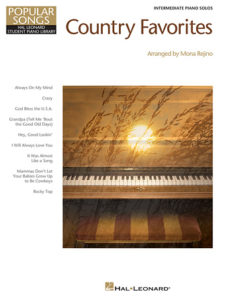 Country Favorites, arranged by Mona Rejino, published by Hal Leonard; Intermediate
Country Favorites, arranged by Mona Rejino, published by Hal Leonard; Intermediate
October/November 2012 – American Music Teacher
Country Favorites, arranged by Mona Rejino, is a recent release in the Hal Leonard Student Piano Library supplement collection. This 39-page book of intermediate piano solos contains nine “classic” country tunes with lyrics including “Always On My Mind,” “Hey, Good Lookin’” and “Rocky Top.”
The first benefit I noticed about this collection is that although the songs are arranged with a variety of accompaniment patterns, fingerings fit nicely under the hand. Younger students will easily be able to navigate the keyboard to play the full accompaniment without the reaches being too difficult.
Rejino nicely incorporates introductions, bridges and endings that set up the style of each piece. “Grandpa,” for example, opens with a lyrical introduction that is echoed in verse transitions and in the extended ending. Likewise, the introduction arranged for “It Was Almost Like a Song” is so closely reminiscent of Archie Jordan’s original tune that players will recognize it as soon as they read through the piece. This encouragement motivates students to practice and play the entire song.
Teachers will also appreciate the variety of playing levels within this book. “Mammas Don’t Let Your Babies Grow Up to Be Cowboys,” for example, is designed for early-intermediate with its simple bass line and one note melody, In contrast, “Crazy” challenges students with triple over duple meter, grace notes and liberal left-hand movements.
Because there is such a variety of accompaniment styles over popular melodies in this book, adding chord symbols or offering a lead sheet/lyric option would be a smart pedagogy move. Teachers might like added chord symbols to encourage students to learn and practice reading a lead sheet or to improvise and experiment with their own accompaniment patterns. It might also be helpful and fun to include a YouTube video link for students to see and hear the style of each piece performed by the original artist. -Reviewed by Serena Hicks, Eagle, Idaho
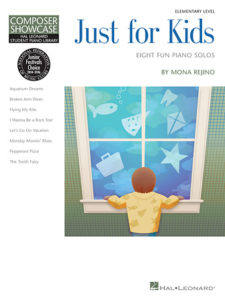 Just for Kids, by Mona Rejino, published by Hal Leonard – Elementary
Just for Kids, by Mona Rejino, published by Hal Leonard – Elementary
August/September 2011 – American Music Teacher
Just for Kids is a charming collection of solos by Mona Rejino for elementary piano students. Featuring eight pieces in a wide range of styles from waltz to rock, Just for Kids will engage students, particularly children aged 8 and under, while stretching them technically and musically.
Children can immediately connect with the kid-friendly titles such as “The Tooth Fairy” and “I Wanna Be a Rock Star.” The imaginative music however will keep them practicing these pieces over and over. Four of the pieces feature particularly satisfying teacher duets. Each piece contains lyrics, which may appeal to young students but may not interest older beginners.
Teachers will appreciate using this collection because it will stretch their students with interesting rhythms and technical challenges. Students will need to be prepared for using accidentals, chromatic shifts and sixth extensions. While none of the pieces contain eighth notes, students will still be challenged by syncopations, ties and rests. Several of the pieces contain ledger line notes, which may be outside the reading range of beginning students but can easily be prepared or taught by rote when introducing a piece.
Many instructors will be thrilled to discover a solo for the left hand only called “Broken Arm Woes.” Complete with tempo changes and moves to a variety of octaves, students will soon forget that they are using only one hand.
Just for Kids is a great choice for teachers to have in their library when they are looking for substantial recital pieces that are more challenging than most method book material. These pieces will motivate students, pushing them while still engaging their imaginations. -Reviewed by Melissa Falb, MacPhail Center for Music
Pop Music
Late Elementary - Intermediate Levels
Solo Collections
Elementary - Intermediate Levels
Essential Elements Piano Theory
Piano Theory in 8 Levels
